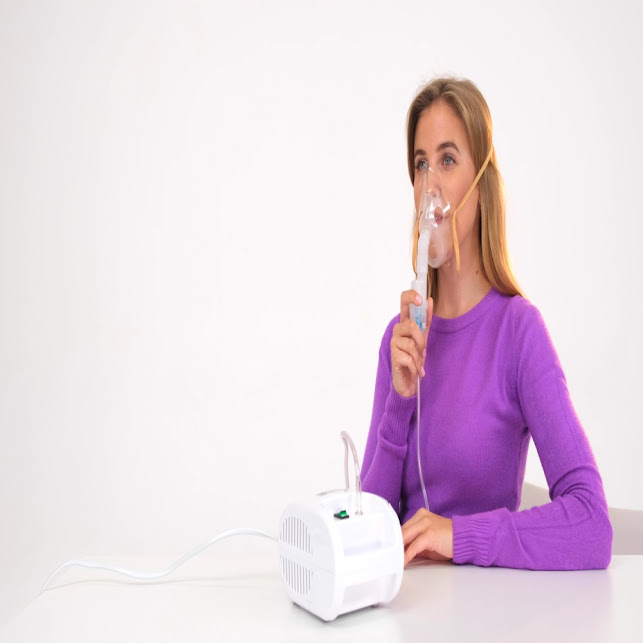Comparing Inhaler Types: MDI, DPI, and SMI Usage and Recommendations
 |
| Respiratory Inhalers |
Types of Respiratory
Inhalers
Metered Dose Inhalers
Metered dose inhalers (MDIs) are one of the most
common types of inhalers used to deliver medicine to the lungs. They contain
liquefied medicine that is released in short bursts from the inhaler. When a
person uses an MDI, they exhale fully, place their mouth around the mouthpiece,
and press down on the canister to release the medicine as they breathe in
slowly and deeply. The medicine particles get trapped in the lungs and provide
quick relief. MDIs usually contain fast-acting bronchodilators that relax muscles
in the airways to relieve coughing, wheezing, and shortness of breath
associated with asthma or COPD.
Dry Powder Inhalers
Dry powder inhalers (DPIs) deliver medication to the lungs in a powder form
without the need for an propellant gas. They contain medication that has been
processed into a single or multi-dose dry powder that is inhaled through the
mouth from the device. When using a DPI, the person inhales quickly and deeply
through the mouthpiece which helps powder particles break apart and travel to
the lungs. Common medications dispensed via DPI include bronchodilators,
steroids, and antibiotic powders. Respiratory
Inhalers Compared to MDIs, DPIs require a stronger inhalation to
disperse powder and may be harder for some patients to use properly.
Soft Mist Inhalers
Soft mist inhalers (SMIs) or nebulizers utilize liquid medication that is
aerosolized through the breath and a piezoelectric crystal. Upon actuation, the
crystal vibrates at high speed turning liquid medication into a very fine mist
or aerosol that is easily inhaled into the lungs. SMIs are best suited for
patients unable to coordinate breathing with an MDI or DPI. They are preferred
for acute asthma exacerbations in young children and other special populations
with low inhalation capacity. However, SMIs require electricity or batteries to
operate and cannot provide quick relief medication "on-the-go" like
MDIs and DPIs.
Usage Recommendations for Different
Patient Types
Children
Inhalers can be challenging for children to effectively use. MDIs may
require hand-breath coordination that is difficult for young children to
master. DPIs may require a stronger breath that children may not be able to
produce. SMIs are usually more convenient for young children as they do not
require coordination and provide medicine through normal breathing. Older
school-aged children may be capable of using MDIs and DPIs if trained properly.
Using an inhalation spacer device or facemask with an MDI can help small
children receive their medication effectively.
Adults
For most adults, MDIs and DPIs tend to be the preferred options. They
provide quick relief medication that can be easily self-administered. Proper
technique includes exhalation, placement of mouth around the mouthpiece, and
slow inhalation for MDIs or fast, deep inhalation for DPIs. SMIs are useful
when an individual cannot coordinate their breathing or use their inhaler
effectively, such as during an asthma attack.
Elderly Patients
The elderly population may experience difficulties using inhalers due to
physical limitations, cognitive impairment, or dexterity issues involving hand
and breath coordination. DPIs tend to be harder for them to use compared to
MDIs. SMIs that do not require exhalation or a strong inhalation breath can be
safer and more effective options. It is also important for caregivers of
elderly patients to ensure proper inhaler technique is being followed through
regular reviews with the patients.
Tips for Effective Respiratory Inhalers
Use
Regardless of the type of inhaler, there are a few general tips to help ensure
medication is being delivered effectively to the lungs:
1. Shake the inhaler well before each use to re-suspend medication if
prescribed.
2. Exhale fully before placing the inhaler in mouth.
3. Seal lips around the mouthpiece and inhale slowly and deeply over 3-5
seconds for MDIs. Inhale quickly for one full breath for DPIs.
4. Hold breath for 10 seconds to allow medication time to fully reach target
airways before exhaling.
5. Rinse mouth with water after use to prevent side effects like thrush.
6. Clean inhalers regularly according to manufacturer instructions to prevent
clogging.
7. Seek medical advice if not receiving full symptom relief or having
difficulties using the inhaler properly.
Get more insights on
Respiratory
Inhalers
Alice Mutum is a seasoned senior content editor at Coherent Market Insights,
leveraging extensive expertise gained from her previous role as a content
writer. With seven years in content development, Alice masterfully employs SEO
best practices and cutting-edge digital marketing strategies to craft
high-ranking, impactful content. As an editor, she meticulously ensures
flawless grammar and punctuation, precise data accuracy, and perfect alignment
with audience needs in every research report. Alice's dedication to excellence
and her strategic approach to content make her an invaluable asset in the world
of market insights.
(LinkedIn: www.linkedin.com/in/alice-mutum-3b247b137
)


%20Treatment%20(1).jpg)
Comments
Post a Comment